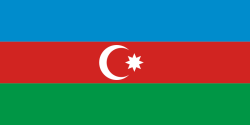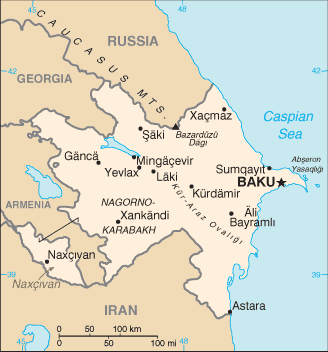Republic of Azerbaijan
Related Categories:
 Flag of Azerbaijan
Flag of AzerbaijanThree equal horizontal bands of blue (top), red, and green; a crescent and eight-pointed star in white are centered in red band. |
 Embassy of Azerbaijan - National Symbols
Embassy of Azerbaijan - National SymbolsAfter the collapse of the Democratic Republic in April 28, 1920 and the establishment of the Soviet regime this flag was relinquished in Azerbaijan. Yet the flag was restored by the order of the Supreme Medjlis of the Nakhichevan Autonomous Republic and was declared the national flag of the Autonomous Republic on November 17,1990.
www.azembassy.com/
Meaning of the flag, coat of arms, anthem.
www.fotw.us/
The earliest known inhabitants of what in present day Azerbaijan were the Caucasian Albanians, a Caucasian-speaking people who appear to have been in the region prior to the host of peoples who would eventually invade the Caucasus.
en.wikipedia.org/
Azerbaijan combines the heritage of two venerable civilizations--the Seljuk Turks of the 11th century and the ancient Persians. Its name is thought to be derived from the Persian phrase "Land of Fire," referring both to its petroleum deposits, known since ancient times, and to its status as a former center of the Zoroastrian faith. The Azerbaijani Republic borders the Iranian provinces of East and West Azerbaijan, although they have not been united into a single state in modern times.
Little is known about Azerbaijan's history until its conquest and conversion to Islam by the Arabs in 642 AD. Centuries of prosperity as a province of the Muslim caliphate followed. After the decline of the Arab Empire, Azerbaijan was ravaged during the Mongol invasions but regained prosperity in the 13th-15th centuries under the Mongol II-Khans, the native Shirvan Shahs, and under Persia's Safavid Dynasty.
Due to its location astride the trade routes connecting Europe to Central Asia and the Near East and on the shore of the Caspian Sea, Azerbaijan was fought over by Russia, Persia, and the Ottomans for several centuries. Finally the Russians split Azerbaijan's territory with Persia in 1828 by the Treaty of Turkmenchay, establishing the present frontiers and extinguishing the last native dynasties of local Azerbaijani khans. The beginning of modern exploitation of the oil fields in the 1870s led to a period of unprecedented prosperity and growth in the years before World War I.
At the collapse of the Russian Empire in 1917, an independent republic was proclaimed in 1918 following an abortive attempt to establish a Transcaucasian Republic with Armenia and Georgia. Azerbaijan received de facto recognition by the Allies as an independent nation in January 1920, an independence terminated by the arrival of the Red Army in April. Incorporated into the Transcaucasian Federated Soviet Socialist Republic in 1922, Azerbaijan became a union republic of the U.S.S.R. (Soviet Union) in 1936. The late 1980s were characterized by increasing unrest, eventually leading to a violent confrontation when Soviet troops killed 190 nationalist demonstrators in Baku in January 1990. Azerbaijan declared its independence from the U.S.S.R. on August 30, 1991.
www.state.gov/r/
Introduction
About
Contact
Symbols in The News
Interpret this Symbol
AAC
African
AI
Alchemy
Alphabets
Ancient
Animal Symbolism
Architecture
Art
Articles
Astrology
Baha'i
Blissymbolics
Blueprint Symbols
Buddhist
Celtic Symbols
Cemetery
Chinese Symbols
Christian
Circle
City
Codes
Color
Conlangs
Crop Circles
Danger
Da Vinci Code
Designing Logos
Dictionaries
Dreams
Education
Egyptian Symbols
Electrical
Emoticons
Find Images
Fonts
Food
Fraternity
Hamsa
Healing
Heraldry
Hermetic
Highway Signs
Hindu
History
Hobo
Holiday
Icons
iConji
Islamic
Jain Symbols
Japanese, Kanji
Jewish
Justice
Law
Literary Symbolism
Mandalas
Map
Masonic
Math, Number
Meaning of Names
Medical
Middle East
Military
Miscellaneous
Money
Music
Mythology
Native American
Playing Cards
Power
Psychology
QiQiiKhu
Reiki
Religious
Runes, Norse
Sacred Geometry
Scientific
Science Fiction
Sorority
Sports
Symbols in the News
Tattoos
ThirteenSymbols
Tree of Life
Ursprache
Videos
Visual Languages
Weather
Web Codes
Wicca
Words
Writing Systems
Braille
Coinherence
Coptic
Cuneiform
Easter Island
Etruscan
Happy Human
Hebrew
Kokopelli
Linear B
Lotus
Love Symbols
Mandorla
Moon Alphabet
Nine Pointed Star
Om
Oz
Phonetic
Scarab Beetle
Silent
Theosophy
Unifon
About
Contact
Symbols in The News
Interpret this Symbol
AAC
African
AI
Alchemy
Alphabets
Ancient
Animal Symbolism
Architecture
Art
Articles
Astrology
Baha'i
Blissymbolics
Blueprint Symbols
Buddhist
Celtic Symbols
Cemetery
Chinese Symbols
Christian
Circle
City
Codes
Color
Conlangs
Crop Circles
Danger
Da Vinci Code
Designing Logos
Dictionaries
Dreams
Education
Egyptian Symbols
Electrical
Emoticons
Find Images
Fonts
Food
Fraternity
Hamsa
Healing
Heraldry
Hermetic
Highway Signs
Hindu
History
Hobo
Holiday
Icons
iConji
Islamic
Jain Symbols
Japanese, Kanji
Jewish
Justice
Law
Literary Symbolism
Mandalas
Map
Masonic
Math, Number
Meaning of Names
Medical
Middle East
Military
Miscellaneous
Money
Music
Mythology
Native American
Playing Cards
Power
Psychology
QiQiiKhu
Reiki
Religious
Runes, Norse
Sacred Geometry
Scientific
Science Fiction
Sorority
Sports
Symbols in the News
Tattoos
ThirteenSymbols
Tree of Life
Ursprache
Videos
Visual Languages
Weather
Web Codes
Wicca
Words
Writing Systems
Braille
Coinherence
Coptic
Cuneiform
Easter Island
Etruscan
Happy Human
Hebrew
Kokopelli
Linear B
Lotus
Love Symbols
Mandorla
Moon Alphabet
Nine Pointed Star
Om
Oz
Phonetic
Scarab Beetle
Silent
Theosophy
Unifon
